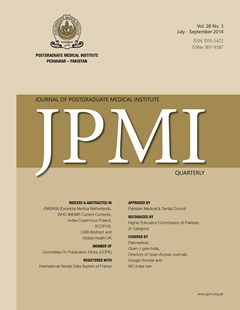The improvement in the ABI index following 3 month treatment with cilostazol in patients with mild to moderate peripheral arterial disease
Main Article Content
Abstract
Objective: To study the effects of cilostazol in patients with mild to moderate peripheral arterial disease (PAD) using the improvement in ankle brachial pressure index (ABI).
Methodology: This hospital based interventionist study was a prospective, open labeled clinical trial. After the baseline data collection cilostazol was given to the group A, while the group B didn't receive cilostazol. The effect of intervention was noted at the timed study points at 4, 6 and 12 weeks .The antiplatelets were used in the group B as a control.
Results: The ABI improvement at the end of the study in the cilostazol treated group was marked compared with the control group. The group A had 65 males and 35 females, while the group B had 74 males and 26 females. The total ABI improved in the right and left lower limb with a P value of 0.001 each. The ABI results were better in the male, diabetic and hypertensive subsets of study as compared with female, obese and smoker.
Conclusion: Cilostazol significantly improves ABI in PAD. Its use in the indicated population group should be encouraged to improve the management and prevent the complications.
Article Details
Work published in JPMI is licensed under a
Creative Commons Attribution-NonCommercial 2.0 Generic License.
Authors are permitted and encouraged to post their work online (e.g., in institutional repositories or on their website) prior to and during the submission process, as it can lead to productive exchanges, as well as earlier and greater citation of published work.


